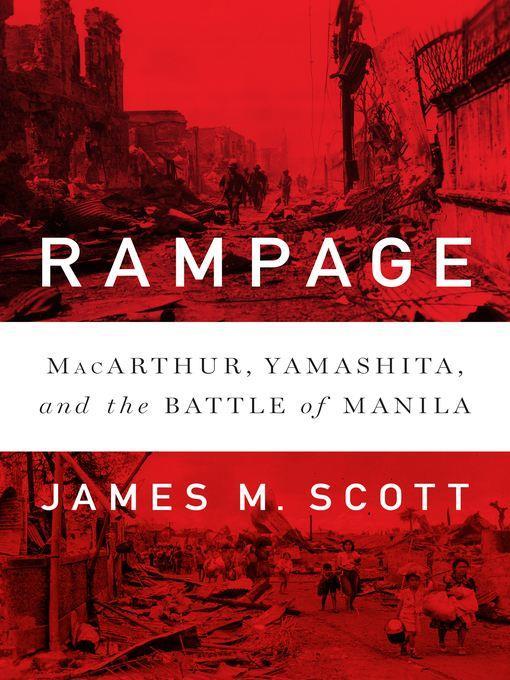
Rampage
MacArthur, Yamashita, and the Battle of Manila
کتاب های مرتبط
- اطلاعات
- نقد و بررسی
- دیدگاه کاربران
نقد و بررسی

August 15, 2018
A scarifying history of a terrible moment in the Pacific War.In 1945, Douglas MacArthur returned to the Philippines as he had promised, wanting nothing more than a spectacular military parade through the streets of Manila. The Japanese commander of forces in the field, Tomoyuki Yamashita, the "Tiger of Malaya," intended to oblige by withdrawing his soldiers from the city, but an admiral named Sanji Iwabuchi had other ideas. Defying orders, he commanded his sailors and marines to dig in for a house-to-house defense of the city, co-opting some army units in the bargain. With certain death their only option, Iwabuchi's command embarked on a campaign of atrocities in which more than 100,000 Filipinos and foreign nationals were slaughtered, with orders that they be grouped to save ammunition and then disposed of by burning buildings and, with them, material evidence of the massacre. Historian Scott (Target Tokyo: Jimmy Doolittle and the Raid that Avenged Pearl Harbor, 2015, etc.) holds that "Manila has never truly recovered from the battle"; though a gleaming, modern city at its edges, the old heart remains scarred and in some places unreconstructed. Moreover, he adds, Iwabuchi's orgy of violence was not an isolated instance of soldiers without any other hope playing out their last traces of aggression against an enemy that could not fight back. Instead, it was "a pattern of Japanese brutality that played out across Asia," a bookend to the Rape of Nanking. Scott's narrative, studded with nearly unimaginable atrocity, makes for difficult reading, but one cannot argue with that thesis after reading about babies bayoneted in the face, women gang-raped by squadrons of soldiers, and men burned alive. Iwabuchi killed himself rather than face justice, and not many Japanese soldiers survived the relentless American siege. As for Yamashita, though there is some evidence to suggest that he truly had no control over the rogue commander and his troops, he was hanged as a war criminal, a fate that few readers will lament.Painful but necessary reading for students of World War II.
COPYRIGHT(2018) Kirkus Reviews, ALL RIGHTS RESERVED.

Starred review from August 27, 2018
Historian and Pulitzer Prize finalist Scott (Target Tokyo) vividly captures the mayhem and horrors that took place during the 29-day Battle of Manila in the closing months of WWII—more than 100,000 civilians were killed, many of them massacred by Japanese fighters, and most historic buildings were destroyed before Gen. Douglas MacArthur’s troops and Filipino forces took the city. Scott draws on such primary sources as diaries, letters, news dispatches, investigator records, and survivor testimony to create a compelling human picture. As one contemporaneous observer wrote, “In Manila they have piled outrage on outrage, infamy on infamy, until it has become a city of nightmarish horrors.” Although the stories of opposing generals MacArthur and Tomoyuki Yamashita bookend the narrative and the battle is recreated in dramatic detail, this is not purely a military history: the stories of Filipinos and expatriates caught in the crossfire are thoughtfully told. Violent and harrowing atrocities are interspersed with brief moments of humanity and humor, such as when a U.S. soldier gives a Manila-born youngster a stick of gum and her father has to teach her how to chew it. Told with rich layers of perspective and cinematic immediacy that transports the reader to the streets of Manila, this is a gut-wrenching and rewarding reading experience.

October 1, 2018
Historian Scott's (Target Tokyo) gripping narrative delves deeply into firsthand accounts, war crimes trial transcripts, military reports, and oral histories to document in rich detail the Battle of Manila (1944-45). The heart-wrenching narrative describes the suffering of the civilian population as Japanese Army and Marine units, aware they were fighting a losing battle, murdered and raped scores of people, including German nationals and missionary priests and nuns. Scott reveals how the American military contributed to this humanitarian disaster, with U.S. Gen. Douglas MacArthur insisting on capturing a city he held dear in his heart, despite being urged to concentrate on the northern Philippines. The story continues with the first war crimes trial and conviction in the Pacific of Japanese Gen. Tomoyuki Yamashita (1885-1946), known as the "Tiger of Malay," who was tasked with the defense of the Philippines. VERDICT Anyone interested in World War II history as well as admirers of Iris Chang's The Rape of Nanking will find this work difficult to put down and solidly engaging.--Chad E. Statler, Westlake Porter P.L., Westlake, OH
Copyright 2018 Library Journal, LLC Used with permission.

























دیدگاه کاربران